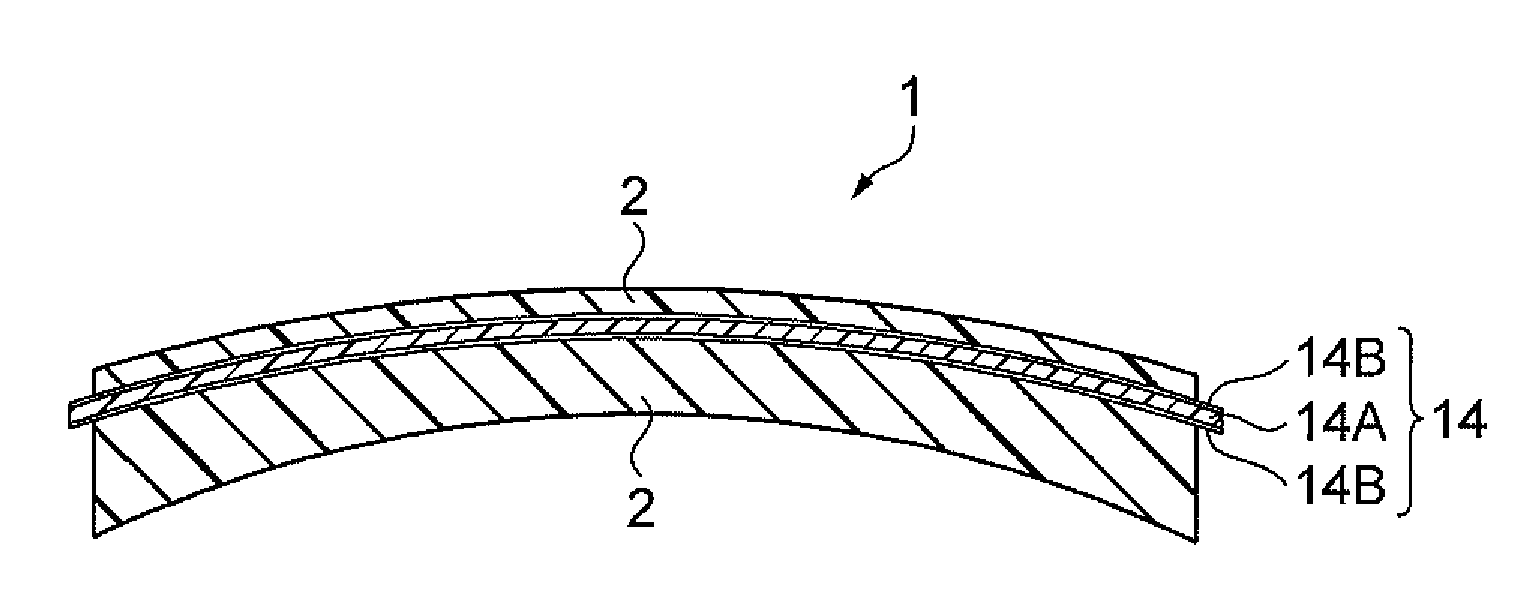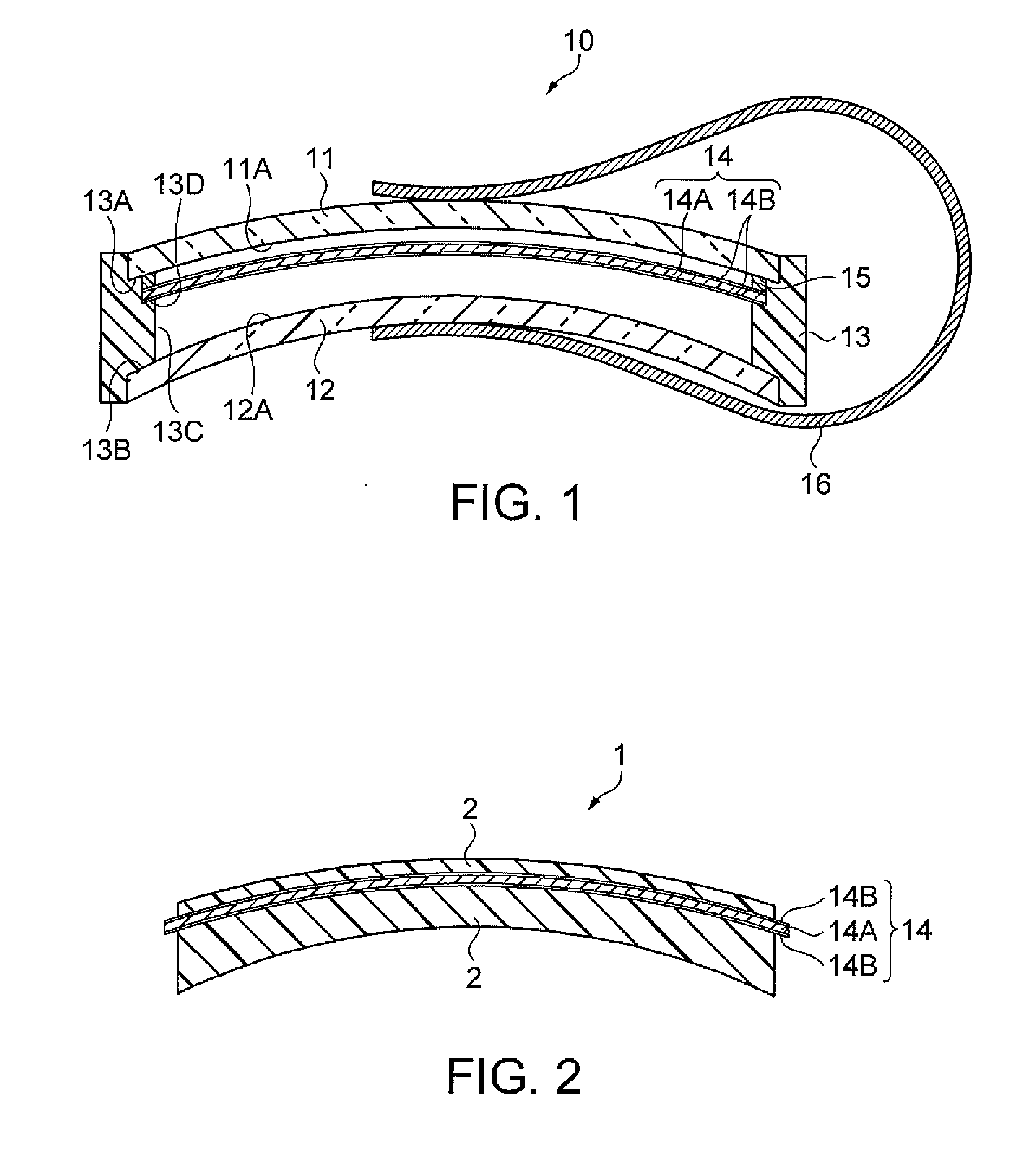Plastic Polarized Lens
a polarized film, plastic technology, applied in the direction of polarizing elements, lighting and heating apparatuses, instruments, etc., can solve the problems of remarkable distortion of the surface and distortion of the polarized film. , to achieve the effect of small lens thickness, excellent appearance and high refractive index
- Summary
- Abstract
- Description
- Claims
- Application Information
AI Technical Summary
Benefits of technology
Problems solved by technology
Method used
Image
Examples
example 1
Preparation of Polymerization Composition
[0090]103 g of m-xylenediisocyanate as a polyisocyanate compound, 100 g of 4,8, or 4,7 or 5,7-dimercaptomethyl-1,11-dimercapto-3,6,9-trithiaundecane as a polythiol compound, 0.15 g of Zelec UN (a trade name, produced by Stepan Company) as an internal releasing agent, and 2.4 g of SEESORB 701 (a trade name, produced by Shipro Kasei Kaisha) as an ultraviolet ray absorbent were mixed and agitated for about one hour. Thereafter, 0.06 g of dibutyltindichloride as a polymerization catalyst was added and dissolved by agitating, and the mixture was degassed under vacuum of 5 mmHg for 60 minutes to prepare a polymerization composition of thiourethane plastics. Hereinafter, the polymerization composition thus produced is referred to as a polymerization composition PCA.
Assemble of Lens Forming Mold
[0091]A commercially available iodine polarized film (having a refractive index of 1.47) was prepared as a polarized film substrate 14A, which was curved to a...
example 2
[0099]In Example 2, the preparation of the polymerization composition, the assembling of the lens forming mold, and the production of the plastic polarized lens were carried out in the same manner as in Example 1 except that a polarized film 14 having the antireflection layer B formed instead of the antireflection layer A was used. Accordingly, detailed description is omitted herein. The plastic polarized lens 1 thus produced had a refractive index of 1.67.
example 3
[0100]In Example 3, a plastic polarized lens was produced by using a polymerization composition of thioepoxy plastics and a polarized film 14 having the antireflection layer C formed on the polarized film substrate 14A.
Preparation of Polymerization Composition
[0101]90 g of bis(β-epithiopropyl)disulfide as a thioepoxy compound, 10 g of 4,8, or 4,7 or 5,7-dimercaptomethyl-1,11-dimercapto-3,6,9-trithiaundecane as a copolymerization component, and 1.0 g of SEESORB 701 (a trade name, produced by Shipro Kasei Kaisha) as an ultraviolet ray absorbent were mixed and completely dissolved by sufficiently agitating. Thereafter, 0.03 g of N,N-dimethylcyclohexylamine and 0.08 g of N,N-dicyclohexylmethylamine as a catalyst were added, and the mixture was sufficiently agitated at room temperature to obtain a uniform composition. The composition was degassed under reduced pressure of 5 mmHg for 30 minutes to prepare a polymerization composition of thioepoxy plastics. Hereinafter, the polymerization ...
PUM
| Property | Measurement | Unit |
|---|---|---|
| Current | aaaaa | aaaaa |
| Digital information | aaaaa | aaaaa |
| Refractive index | aaaaa | aaaaa |
Abstract
Description
Claims
Application Information
 Login to View More
Login to View More - R&D
- Intellectual Property
- Life Sciences
- Materials
- Tech Scout
- Unparalleled Data Quality
- Higher Quality Content
- 60% Fewer Hallucinations
Browse by: Latest US Patents, China's latest patents, Technical Efficacy Thesaurus, Application Domain, Technology Topic, Popular Technical Reports.
© 2025 PatSnap. All rights reserved.Legal|Privacy policy|Modern Slavery Act Transparency Statement|Sitemap|About US| Contact US: help@patsnap.com



